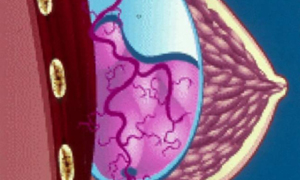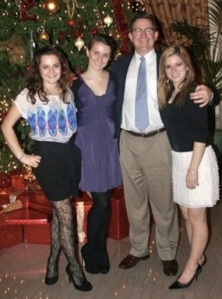Give me a Double Portion of Your Spirit
By Claudia on April 5, 2010 | Category: Claudia's Blog | 3 CommentsThe day before Easter, my aunt happened to find the DVD of my grandmother’s funeral. Its been nearly three years since I’ve heard the eulogy, the hymns, and the loving testimony my father presented. As she described me on the day of my birth, my grandmother was truly “major beautiful”. She was the first female Baptist minister in Dallas, the fourth in the state of Texas, and her love knew no boundaries or obstacles. She simply followed God’s calling, which upset a lot of people at the time. Eventually she had to join the Methodist faith in order to preach from the pulpit. And while her sermons were always moving, it was the way she lived her life and loved indiscriminately that changed so many lives, including my own. Memamma, as you used to ask the Lord, give me a double portion of your spirit.
My grandmother in 2005, before she became sick for the last time.
After radiation, chemotherapy, and a mastectomy on her right breast with reconstruction, my friend is cancer free! Now she is planning to have the other mastectomy later this year, just to make sure the cancer doesn’t get a chance to strike again. That’s another down side to the BRCA1 mutation: we’re more likely to develop breast cancer in a second breast. That’s why genetic counselors will ask if there was ever a woman in your family history to develop breast cancer in both breasts – it’s generally a red flag for a BRCA1 mutation.
As my friend and I munched on our Whole Foods dinner, she shared with me her experience battling cancer and reconstructing a breast already plagued by disease and treatment. It’s difficult, she said, to reconstruct after radiation. The treatment makes your skin tough. As a result, her plastic surgeons replaced some of her radiated breast skin with a strip of healthy skin from her back. While she’s pleased with her surgeon’s work, she’ll be the first to tell you that a reconstructed breast after cancer looks very different than a reconstructed breast before cancer.
After dinner we walked around Old Town Alexandria and discussed our upcoming prophylactic mastectomies. In fact, she wants to have her surgery in November, around the same time I’m planning to have mine! We giggled about calling each other after surgery, comparing notes, and getting updates.
While we’re anxious to have the surgery, we realized that we share the same sorrow- the inability to breastfeed after a mastectomy. We’re both quietly grieving. It saddens us to think that we’ll never have the opportunity to share in this life-giving experience, one that is so primal and yet so feminine and universal. My friend and I are also health nuts (especially in response to cancer and learning of our BRCA1 mutations), and it is hard to accept the fact that our children might never have the irreplaceable nutrition of breast milk. Although, I’m still teasing with the idea of a wet nurse. I know the practice is a little outdated by a hundred years or so, but maybe there’s a way to at least get a friend to pump for me. Any volunteers? Hopefully I won’t need you for a few more years!
I also found it interesting that my friend shared another feeling of mine – we’re both far more reluctant to give up our ovaries. Breasts they can reconstruct, and now it is difficult for anyone but doctors to realize that a woman’s had a mastectomy with reconstruction. They can do that good of a job! But our ovaries, those are different. Life begins in our ovaries, and it’s these organs that truly differentiate us from men. I actually had the chance to see my ovaries during a pelvic ultrasound a few months ago. The experience was surreal, to be able to see the organs that make me a woman but are defenseless to cancer. I’ll have them removed by the age of 40, because I do not want to meet the same fate as my grandmother, but I’ll grieve every step along the way.
As for our breasts, my friend shared with me some exciting research in the field of reconstruction! The one setback with reconstruction after a mastectomy is that the implants don’t always look natural. Because surgeons have to scrape out everything, the silicon or saline implants sometimes look like they’ve just been tacked to your chest. In other words, there’s not a lot of natural curving, as seen in other women’s breasts. But researchers are hard at work trying to develop new ways to make reconstructed breasts look as natural as possible, as my friend related.
For instance, a lot of women now use a regenerative tissue called AlloDerm to help implants look more natural. I’ve heard nothing but good reviews, although I was little taken aback when I heard that AlloDerm is basically dead people’s skin. But if that’s going to do the trick then I’ll need to get over it. Still, it grosses me out, not going to lie.
Another neat development my friend described is the creation of “gummy bear” implants. These silicon implants feel kind of like gummy bears, hence the name, but they feel and look much like women’s natural breasts. In gummy bear implants, the silicon particles hang together in such a way that allows for surgeons to form them to resemble a woman’s natural teardrop breast shape. Better yet, they keep their shape once implanted. Although, I have to say, a part of me is excited to have breasts that will never sag with standard silicon or saline implants. But I’d love to know if doctors could go back in a few years and trade out my implants for the gummy bear or stem cell version. Could they reconstruct the reconstruction?
By the end of the evening, my friend and I realized that we both inherited our BRCA1 mutation from our fathers. While my friend and I love the support network established for us and other young women in the high risk community, it saddens us to see that there is essentially nothing for the fathers and sons in our families. Both of our fathers have struggled with the guilt of knowing that they’ve passed on a dangerous mutation to their daughters. My friend’s dad saw this mutation rear its ugly head in his daughter when she was diagnosed with breast cancer at 24. Our fathers now accompany us to doctor consultations and will walk us into surgery in a few short months. They, too, are feeling so much right now.
Since there’s no support network for men, my friend and I took initiative to create one for our fathers. Last night, we introduced our dads to each other through email, and hopefully they’ll be able to share stories, feelings and experiences as BRCA1+ dads of BRCA1+ daughters. If anything, I don’t want our dads to feel alone. Sometimes it’s just reassuring to know there’s someone else in your shoes.
In the meantime, my friend gave me the name of two women in New York City who she’s met through Be Bright Pink and who, she feels, may be able to help me along my journey. I hope to meet with them when I visit NYC for my surgeon consultations on June 1st. Both are accomplished young women who have already had the prophylactic mastectomy with reconstruction, and both could not be happier with the results. In fact, one woman recently had her first child, and I’m anxious to learn about her experience with pregnancy and as a new mother with reconstructed breasts.
Every time I meet with a fellow high-risk sister, I’m overwhelmed by their openness and eagerness to share their story with me. Over the past couple of weeks, I’ve even seen two women’s reconstructed breasts in restaurant bathrooms! Their courage is contagious and inspiring. I could never venture this journey without the foresight and advice of the brave women who have blazed the path for me. Give me a double portion of your spirit, BRCA sisters.
3 Responses to “Give me a Double Portion of Your Spirit”
Leave a Reply
Recent Comments
- on A Previvor at Last!
- on RESOURCES
- on Here Goes Nothing
- on RESOURCES
- on MEDIA
Categories
- Claudia's Blog (19)
- Previvor Stories (23)
- Webisodes (9)




Francesca
September 3, 2010 at 2:45 amI love this entry! What a great idea introducing your dads. Everybody deserves to have somebody to lean on. 🙂
Eli
September 3, 2010 at 2:46 amYou’re truly inspirational!! Being a NICU nurse and knowing the importance of breast milk, I totally understand your worries. There are banks for breast milk that is processed so that the bad stuff (or stuff that could hurt/not help the baby) is taken out. So even if one of your friends doesn’t happen to have a baby at the same time, there are options to get breast milk! It is a little expensive, but you should for sure look into it – when the time comes! When you’re in Nashville again, I’d love to grab lunch!
Tovah
September 3, 2010 at 2:46 ammy dad should join in on the fun!! he’s a case of where the brca mutation DID cause breast cancer! (this is just my little plug for “men get breast cancer too!)
love the blog, claudia, looks amazing 🙂